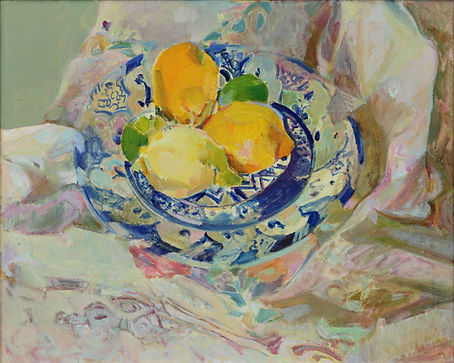Angela Hackett

This painting by Angela Hackett 'Lemons on a Moorish Plate' is the subject and inspiration for a beautiful poem by the Northern Irish poet Ciaran Carson. It was written in 2019 and is included in his final collection of poems 'Still Life', which received wide acclaim.
Read poem below...
'Angela Hackett, “Lemons on a Moorish Plate,” 2013'
For Deirdre
We’d been talking about how back in the day we’d nothing much of anything,
Though what there was to wear—the uniform!—was too big. The sleeves
Drooped well below the fingertips. It gave you room to grow into. Years loomed.
Day after day, summer after summer, days were immeasurably longer then,
And the one tin bathful of hot water did the several children one after the other.
Then it seemed in no time at all you were into your teens. Because your birthday
Fell a week before Christmas—December the 18th—you’d have to make do
With the merest token of a family present. A set of bath salts, maybe, or a bar
Of lemon soap the simulacrum of a lemon, and we tried to remember
If such a thing came wrapped in tissue paper like the fruit itself, or was it
See-through cellophane? Then to summon up the names of yesteryear—
Yardley’s April Violets; Morny White Heather; Lenthéric Tweed! It’s the 1960s,
And I see myself wondering what would be appropriate to buy for my mother,
Dazzled by the cornucopian Christmas window display of the chemist’s shop.
All this, believe it or not, was apropos of Angela Hackett’s painting—
Because when looking at a thing we often drift into a memory of something else,
However tenuous the link. Five years and more—ever since I bought it
For your birthday—it’s been hanging on our bedroom wall, pleasing us
To look at it from time to time to see different things in it. Only now has it
Occurred to us to talk about or of it at this length, the lemons—three of them—
Proceeding in an anticlockwise swirl from pale lemon to a darker yellow
To an almost orange, tinged with green—degrees, we speculate, of ripeness
Or decay. You know how lemons, if left too long in the bowl, one or two from time
To time will show a blush of green, a dimple or a bruise of bluish green
That overnight becomes a whitish bloom? So we think Angela Hackett’s lemons
Might be on the turn. Though it’s possible the green tinge might be an echo
Of the two limes I haven’t mentioned until now, nestled in against the lemons
On the indigo-and-white Moorish plate, all of which complicates the picture.
It gave us pause for thought. How long does it take, we wondered, for a lemon
To completely rot? We imagined a time-lapse film, weeks compressed
Into seconds, the lemon changing hue, developing that powdery bloom, then
Suddenly collapsing into itself to leave a shrunken, pea-size, desiccated husk—
The flesh evaporated, breathed into the atmosphere as it transpires.
And that is why on the 26th of March, 2019, we set up the lemon experiment.
On the avocado-and-aubergine-colored Moroccan saucer we bought in Paris
We set a fresh lemon and a banana, whose peel, we are led to believe, releases
Ethylene gas and hence ripens any other fruit with which it comes into contact.
We wanted to see with our own eyes the end of the life cycle of the lemon.
I write this on the 6th of April. The banana has gone black except at the tips.
The lemon looks as fresh as ever. We’ve just been for our daily walk around
The Waterworks. Ducks are kicking up a racket. A blackbird sings
From a blackthorn bush. And as we enter into Glandore from the Antrim Road
How clean and fresh and green are the newly sprung leaves of the chestnut tree!
From 'Still Life', Ciaran Carson (2019),
Reproduced by kind permission of The Gallery Press, Ireland.
